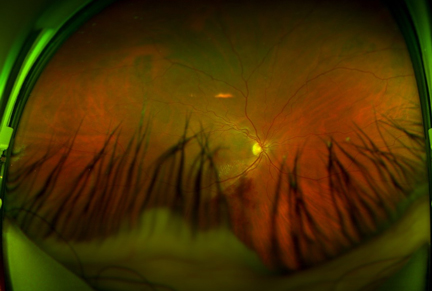
By Linda Hardy, DDO- GA, CPOT, COA
Patients come in every day for a routine eye exam. A great many of them are being treated or observed for high blood pressure. With the alarming increase in obesity, poor diets, lack of exercise and growing stress levels, it is not surprising that so many have high blood pressure. High blood pressure affects several organs in the body, including the heart, kidneys, and eyes. It is important for these patients to have a retinal evaluation yearly, or more often if the blood pressure is uncontrolled.
The definition of high blood pressure is the force of blood pushing against the walls of blood vessels that is consistently too high. Organs need oxygenated blood in order to function properly. The circulatory system carries this blood throughout the body. When the heart beats, it pushes blood through a network of blood vessels. Blood pressure is the measure of two forces, systolic pressure, and diastolic pressure. Systolic pressure occurs when the blood pumps out of the heart and into the arteries. Diastolic pressure happens when the heart rests between beats. During the diastolic phase, the heart fills with blood and gets oxygen. Blood pressure readings indicate these two forces as systolic over diastolic. (Example: 120/80)
The force and friction of high blood pressure damage arteries. The more damage, the smaller the inside of an artery becomes. This can lead to cholesterol forming plaques along tiny tears in the arteries. This is the beginning of arteriosclerosis, which can lead to other health issues such as heart attack and stroke.
When blood pressure goes untreated or is consistently high, it can damage the retina. There are small blood vessels in the retina that carry oxygen to keep it healthy and functioning properly. These vessels can become damaged due to hypertension. The walls of the vessels can thicken, which will decrease the blood flow through the vessels. Areas of the retina will become damaged due to inadequate blood supply. This is called hypertensive retinopathy.
The longer a patient has hypertension, the weaker the vessels in the retina become. At some point, the vessels begin to leak. This can lead to vision loss especially if the macula is affected. If a person’s blood pressure continues to be out of control, the veins in the retina can become dilated and twisted. The optic disc may become swollen; a condition called papilledema.
To determine the presence of hypertensive retinopathy, the ECP examines the retina to look for indicators including:
• Narrowing of blood vessels
• Spots on the retina (cotton wool spots and exudates)
• Swelling of the macula (the central area of the retina) and optic nerve
• Bleeding in the back of the eye
The level of retinopathy will determine the treatment. In many cases, controlling blood pressure will be adequate treatment, along with consistent evaluation/monitoring by an eye doctor. In some cases, the patient may need further care by a retinal specialist.
The goal of treatment for high blood pressure is to keep a person’s blood pressure within a normal range. Long term hypertension can be life-threatening. Complications include stroke, heart attack, heart failure, and permanent vision loss. Routine care with your primary care physician, ophthalmologist, and optometrist protects from these complications.
Learn about protecting vision through healthy eating with our CE, Nutrition, and Vision at 2020mag.com/ce.











